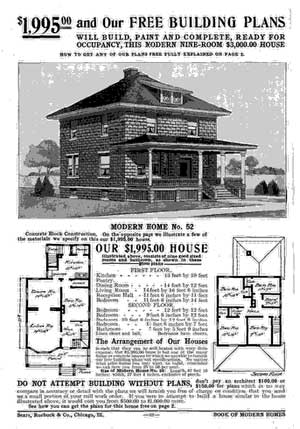Small Home Gazette, Winter 2010
Do-It-Yourself Concrete Blocks
Ever wonder where the concrete blocks used to build your bungalow’s foundation walls came from? No? Well, we’ll tell you anyway.
Instead of coming from a local factory, the blocks might have been molded right at your home’s construction site. Concrete blocks molded in the appearance of cut stone were a turn-of-the century labor and money saver in home construction. Popular for house and porch foundations, they were cheaper than stone and stronger than brick.
This use of concrete originated in 1900 with the invention of a hand-operated machine to cast concrete to look like stone. The inventor, Harmon S. Palmer, created a molding machine out of cast iron; founded the Hollow Building Block Company; and by 1904, was producing about 400 molding machines per year. The interest in this new and inexpensive method of producing building materials grew by leaps and bounds.

The molding machine had six sides and a patented way to open the mold so the block could be removed. Workers filled the mold by hand, tamping down the material around the hollow openings in the middle. The operator then closed the mold and, using levers, changed the position of the mold to a different side. The end doors were released and then, using another lever, the block could be released. The size of the blocks depended on the molding machine. Once the popularity of the concrete block was established, competing companies marketed their own machines. All followed Palmer’s design. For example, the Wizard block-making machine was sold through Sears Roebuck Company catalogs, ranging in price from $42.50 to $63.75. According to an ad in the 1910 catalog, one man could make 125 blocks a day (but 50 to 70 was more likely). The blocks necessary for the average basement would take nearly four weeks to make.
Also by 1910, there were a variety of face designs and decorative details available for molding. The most popular design, standard on all machines, was the rock face rough cut surface or “rusticated limestone” surface that looked like quarried stone. Of the concrete blocks made before 1915, nearly 75 percent were used for foundations. If the blocks were used for partition walls in the interior, they were made with a smooth face.
 By 1924, organizations such as the Concrete Block Manufacturer’s Association, the Concrete Producers Association, and the Concrete Block Machine Manufacturers Association established standard sizes for all blocks. The standard block size for most machines was reduced to 8″ by 8″ by 16″; however, one-half or one-fourth size block attachments were available, as well as gable, bay window, circular and corner block attachments.
By 1924, organizations such as the Concrete Block Manufacturer’s Association, the Concrete Producers Association, and the Concrete Block Machine Manufacturers Association established standard sizes for all blocks. The standard block size for most machines was reduced to 8″ by 8″ by 16″; however, one-half or one-fourth size block attachments were available, as well as gable, bay window, circular and corner block attachments.
After 1930, concrete block began to lose popularity for two reasons. With the rise of modernism, sleek, smooth surfaces had become more stylish. And automated machines with the capability of producing more than one block at a time became available, upstaging hand-tamped units. Improved machines and the growth of the concrete industry into new areas of construction brought an end to the use of ornamental face concrete blocks nationwide.











